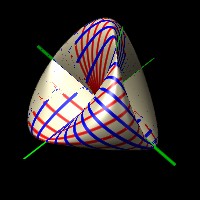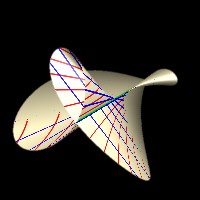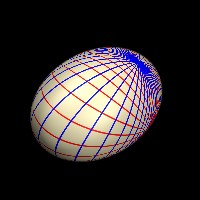


There is a two dimensional family of plane conics on the Veronese surface in P^5 obtained by taking the Veronese image of lines in P^2 . The line au_0+bu_1+cu_2=0 is also in the zero set of u_j(au_0+bu_1+cu_2) so that the image of the line is contained in a two-plane in P^5, and is a rational normal curve there. Each point on the Veronese surface is contained in a P^1 of such plane conics. Under projection the plane conics give either conics (vertex of projection not in the plane of the conic) double lines (vertex of projection in plane of conic but not on conic) or lines. Thus all Steiner surfaces have large numbers of plane conics contained on them. The pictures below illustrate this. The Kronecker-castelnuovo theorem states that if a smooth surface has a two dimensional family of curves on it is either the Veronese Surface or a ruled surface known as a scroll.
The pictures below show the image on various projections of the Veronese surface of the Veronese image of the lines u_0=tu_2 (in red) and u_1=tu_2 (in blue) in the projective plane.

|
Two families of conics on the Steiner Roman surface. The only lines on the Roman surface are the 3 double lines shown in green. The plane of the conics pictured here also intersect the Roman surface in one of the double lines. |

|
Two families of curves on Cayley's ruled cubic. Note the blue lines forming ruling lines for the surface. |

|
Two families of conics on the ellipsoid. |